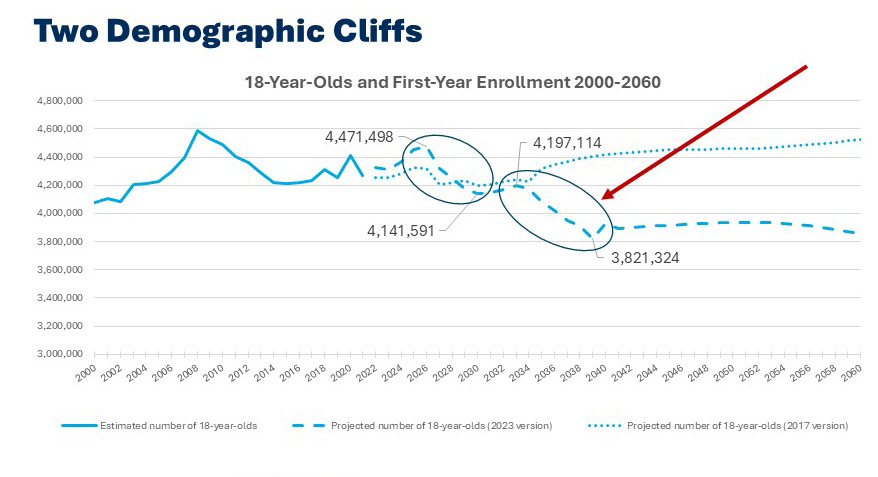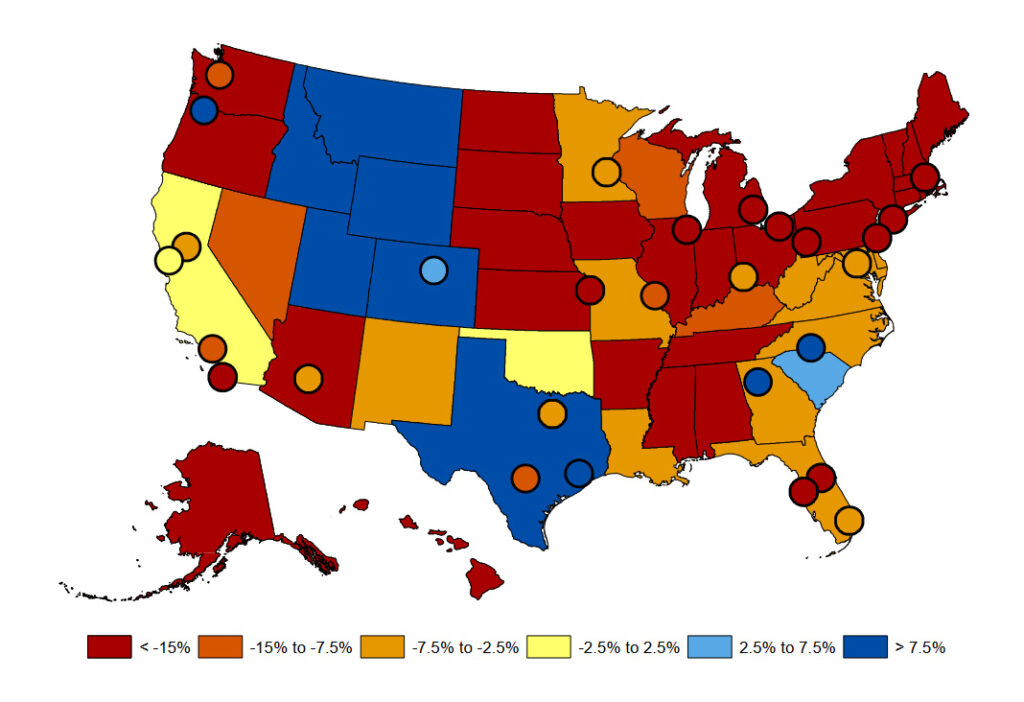enrollment
TWO Demographic Cliffs? How and Why to Diversify Revenue Streams
Well, the academic year in which demographers have long projected that the “demographic cliff” is upon us. For some institutions, it has already arrived, and for others, it is still in the distance, but the inevitability of it affecting institutional health is no longer theoretical, and you need to have plans in place for how to counter smaller numbers of traditional undergraduates. To that end, RNL is offering readers early access to a new paper that lays out a dozen strategies that institutions can use to build alternative revenue (student) streams. Unfortunately, new data from the Census Bureau makes the development of these strategies even more critical. Why? Because these new data—revised population estimates, the first to be built on the 2020 (rather than the 2010) census data—indicate a second demographic cliff in the number of 18 year olds will almost immediately follow the first one.
New data show two demographic cliffs
Below, we present the original 2010 projection (dotted line) upon which Nathan Grawe and others based their warnings about the Demographic Cliff and 2020 revisions (dashed line), which update the data based on the more recent census data. After an initial loss of nearly 330,000 fewer target undergraduates, in 2030 we will see slight and temporary growth as a result of a short post-Great Recession baby boom (+55,000), but the second cliff will see contraction until at least 2039. By the end of that decade, institutions will have nearly two-thirds of a million fewer target undergraduates than they did this fall.

| By the Numbers: | Net New 18-Year-Olds | Percent Change |
| 2026-30: | -329,907 | -7.3% |
| 2030-33: | 55,523 | +1.3% |
| 2033-39: | -375,790 | -9.0% |
| Total Change (2026-39) | -650,174 | -15% |
Uneven change
Nathan Grawe’s 2018 book, Demographics and the Demand for Higher Education, provides the most comprehensive analysis of what is on the horizon. Among dozens of informative charts and tables, his state level projections of change among “college-going” students (calculated using data on 18-year-olds and the other hypotheses laid out in the book) are among the most important. He states, “When population figures are adjusted for the probability of college-going, the situation looks a bit worse (than just the 18-year old data) in two-thirds of the locations.”

Twenty-seven states are projected to contract by more than 15 percent in college-going students (9 west and 15 east of the Mississippi) while 3 more will see as much as 15 percent. Eleven states will see lesser contraction. Only nine states will growth, indicating that for most of the country, enrollment stability (or growth) will require institutions to rethink how they attract and enroll students – or lower their entrance requirements in order to fill their classes. In what follows, we offer a way forward.
What should institutions do to meet the challenge of two demographic cliffs?
Institutions should clearly take steps to maximize enrollment among their traditional undergraduates, but perhaps more importantly they must take steps to diversify and strengthen alternative student audiences. With this in mind, we present two sets of action steps for consideration.
Diversifying Alternative Student Audiences:
- Expand online programming. On which programs should institution focus? Among the 15 most popular online programs at both levels are: business administration, computer science, accounting, psychology, nursing, and healthcare administration. Institutions seeking to differentiate their programs should not look for niche topics but should ensure that high demand programs offer features and specializations that do the work to distinguish programs in a crowded market.
- Focus on master’s programs that will advance careers. Institutions need to ensure that the curriculum for their master’s programs is infused with career-relevant skills, strategies, and practical, career-related simulations. They must also ensure that messaging leads with these career preparation aspects. Institutions that resist the idea that the primary mission of graduate education (or, increasingly, undergraduate) is to prepare students for successful careers—with the skills needed to succeed—will lose to programs that embrace this mission.
- Align graduate and online programs with student expectations and behaviors. How do institutions “win” the student under current conditions? Align programs with the expectations and needs of students – as stated by them, rather than by your instinct about what they need. RNL’s four national studies of online students and graduate students since 2021 provide in-depth insights into what students expect in their program. The most important factors are: programs that prepare students for careers – including applicable skills; programs that respond quickly to inquiries, subsequent questions, and applications; programs that maximize affordability through tuition, aid, credit transfer policies, and reasonable credit requirements; and, programs in which the student can “customize” their content to match their interests through concentrations, electives, and options in culminating experiences.
Download the report to read more about the other strategies that will help you plan for a healthy enrollment future, which includes detailed strategies concerning:
- Developing meaningful strategies to attract those with some college, no degree.
- Bringing graduate and online marketing, recruitment, and admissions in from the cold.
- Bringing AI into your programs.
- Infusing AI into your operations in order to maximize conversion – and enrollment.
- Expanding undergraduate access to individual online courses.
- Applying digital marketing techniques used among other populations to your undergraduate strategy.
- Increasing the focus on undergraduate retention and success – including career preparation.

